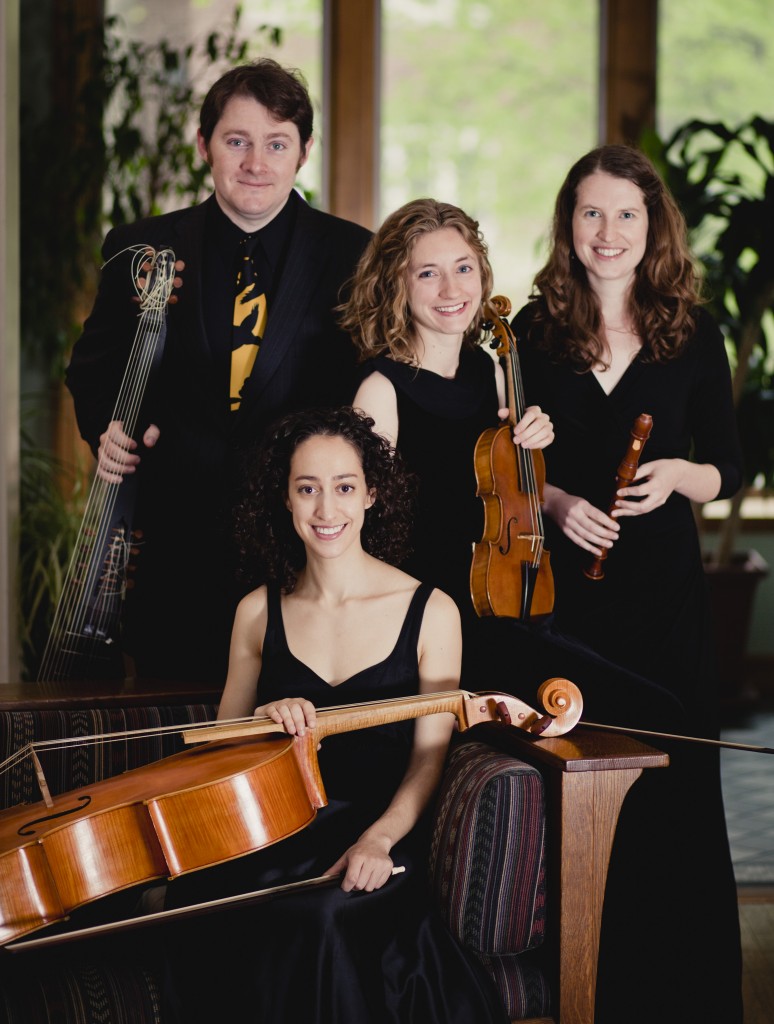Wayward Sisters offer naughty but nice traversal of mountebanks’ music
The Wayward Sisters weren’t all sisters and the composers on their list weren’t all so naughty, but the Chicago-based baroque ensemble presented a worthy program at The Kosciuszko Foundation on Manhattan’s Upper East Side Thursday. The rather gimmicky conceit of the program didn’t quite deliver. Titled “The Naughty List: Music by Braggarts, Hotheads, Curmudgeons, and Snobs,” the concert, presented by Music Before 1800, found the unusual quartet (recorder, theorbo, baroque violin and baroque cello) running through nine pieces by eight composers in just over an hour.
The group launched headfirst into Bach’s Christ, unser Herr, zum Jordan kam,BWV 684, to open the concert. As much debate as the period instrument movement spurs, it was exciting to hear the familiar strains through the plunks of the giraffe-like theorbo (an elongated lute with added bass strings). Anne Timberlake was particularly animated on the recorder, pushing through the breathiness of the instrument to find a purity of tone.
Violinist Edwin Huizinga (who, filling in for Beth Wenstrom, brought the ensemble’s sister quotient down to 50%) set the theme to William Brade’s Chorale and Variations in a beautiful duet with the theorbo (sounding not quite like harp nor harpsichord) before it was handed off to the cello and he was freed to fly in surprising forays that only occasionally dipped back into the formalism maintained by the other two strings.
In introducing the piece, Huzinga explained that Brade was one of the first to compose for solo violin. The murderer Bellerofonta Castaldi, on the other hand, composed exclusively for theorbo, according to regular Wayward Sister John Lenti. His Follia was like a dance, almost flamenco with its brief, boxy upper-register figures offset by the thumb-thumping of the bass strings, resolving in a lovely repetition of single bass notes against quick trills.
Two pieces by Tarquinio Merula showed, according to Timberlake, the troubled and the joyous sides of the composer (charged with acts of indecency toward his pupils). His duet Sonata Prima had moments of fury in the recorder and bits of dissonance in the theorbo in the first half, progressing to a torrent of torment, even for two such small-voiced instruments. The Ciaconna was introduced by recorder and theorbo again, with brisk echoes from the violin and was, as advertised, a more playful pursuit.
Matthew Locke’s Suite No. 6 in D Major was the high point of the night.(the ensemble has released a full CD of Locke’s works). Lush and enveloping strains filled the warm room – its high ceilings and wood paneling provided a lovely acoustic glow. The slow, circular melodies gave way in the fourth and final movement to unexpectedly uptempo, intermingling lines from the violin and bass recorder with strong, fast theorbo and cello counterpoint.
The therobo featured strongly throughout the night. Vivaldi’s Sonata No. 3 in A minor was played as a duet by Lenti and cellist Anna Steinhoff, the composer’s voice coming through unmistakably in the alternating bold and delicate lines. The only time Lenti set the long-necked lute aside was for Nicola Matteis’ Ayres for the Violin: Book 4, which he played on baroque guitar, at times strumming so softly and quickly it sounded nearly like brushes on a snare drum. Once the piece gained momentum, it was positively sprightly with the guitar changing patterns and reshaping as the other three ascended to higher grounds with reaching, repeating figures.
The concert closed with Dario Castello’s Sonata Duodecima, It was a moody piece, maybe rather manic if we are drawing composer personality assessments. The ensemble seemed to be always just at the edge of a cliff without ever falling (or jumping off) then swaying back to remarkable harmonies before leaning toward the edge again. But Castello also pointed to a problem in the formula. Lenti said in his introduction that little is known about the composer, so how did he end up among this sorrowful lot?
Indeed the derelicts didn’t always pass muster. Brade simply couldn’t hold down a job. Locke was a hothead and Vivaldi an egotist (so they explained). Matteis committed the sin of arrogance. The anecdotes drew titters from the audience but surely these were not the naughtiest representatives of the baroque. Where was the murderous Carlo Gesualdo? The gambling and womanizing Niccolo Paginini? Given the moral bar the ensemble set, how many composers of the era might be said to be truly non-naughy? The hook should have simply been “an evening for theorbo and mixed ensemble,” something too rarely heard, at least in these parts.



